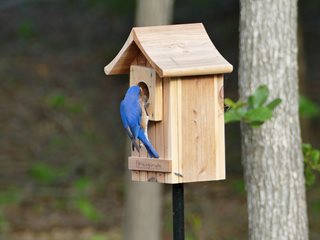Natural Garden Pond Attracts Wildlife
A Delaware couple built their home and gardens around a natural pond that’s a haven for wildlifeWhen Patty Storms and Morty Bachar moved from southern Connecticut to coastal Delaware (USDA Zone 7b), they downsized from a spacious property with a 3-acre pond, pool, and gardens. Their mutual love of nature and wildlife factored into their purchase of a 1-acre lot that abuts a marsh and open woodlands.
Also on this page: Tips for Creating a Wildlife Habitat | Gardening for Wildlife
Also on this page:
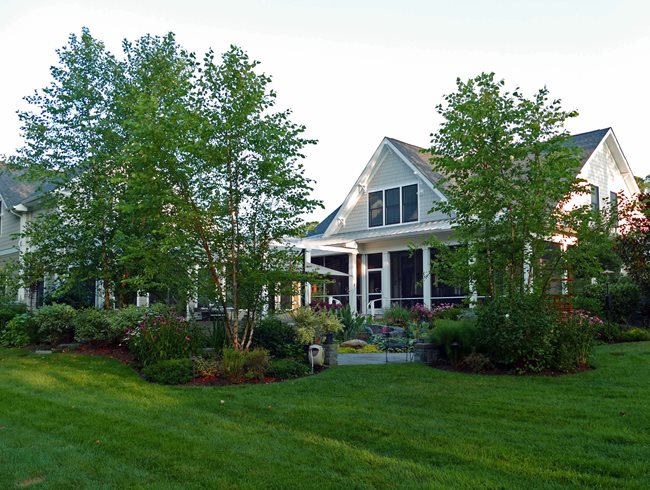
The couple, who are ceramic artists, built their new L-shaped home and studio around a small manmade pond. They worked closely with landscape architect Eric W. Wahl, who was instrumental in bringing their vision to life. The plan included a spacious courtyard and wrap-around porches that overlook the water feature and rest of the property. “We wanted the pond to be front and center to everything else in our living and work spaces so we would feel more connected to nature,” says Patty.
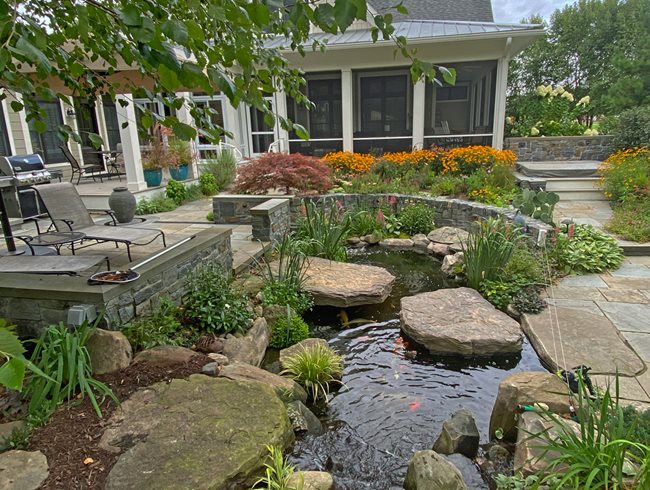
The home features stone patios and sitting areas that look out onto the pond.
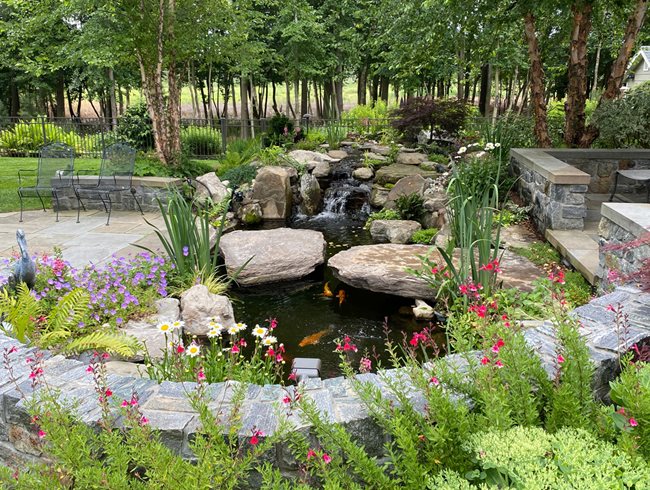
In 2021, the pond was redesigned by landscape designer Mark Voelkel of RSC Landscaping. The existing water feature was disassembled and rebuilt as an eco-friendly self-cleaning pond with a cascading waterfall. Filters, aquatic plants, and beneficial microorganisms reduce harmful algae, purify the water, and create a healthy ecosystem. Similar to the self-regulating process of natural wetlands, these eco-friendly features eliminate the need for chemicals, reduce maintenance, and make the pond safe for all forms of wildlife. The waterfall keeps water circulating to improve aeration and prevent stagnation.
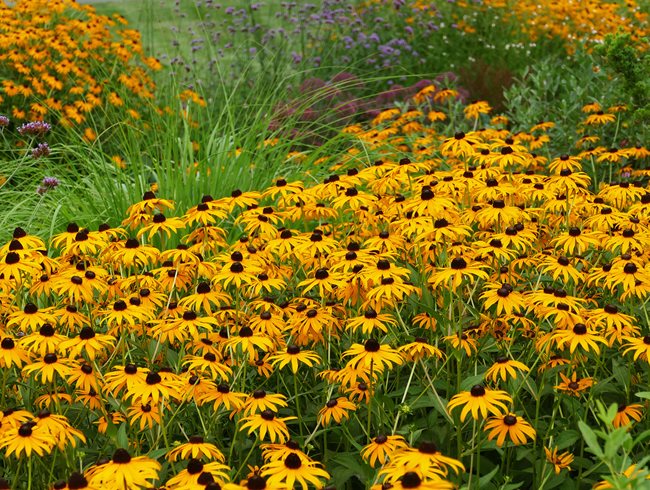
Black-eyed Susan (Rudbeckia fulgida ‘Goldsturm’), which is endemic to prairies and woodlands of North America, is one of many native perennials that provide food for songbirds through fall and into winter.
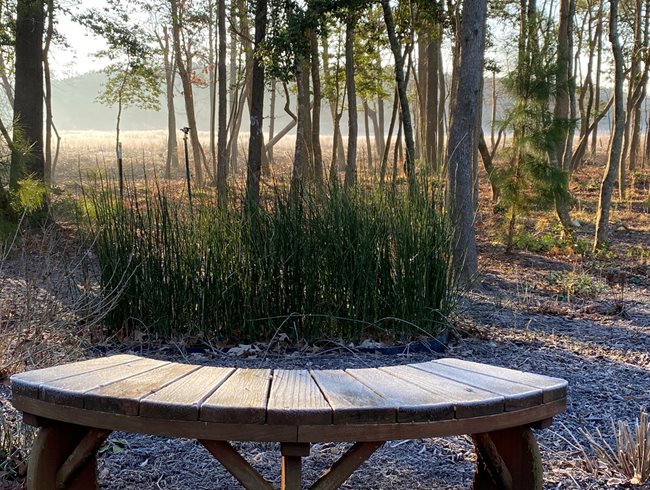
A bench looks out onto the adjacent natural area, offering a peaceful spot to rest and observe wildlife.
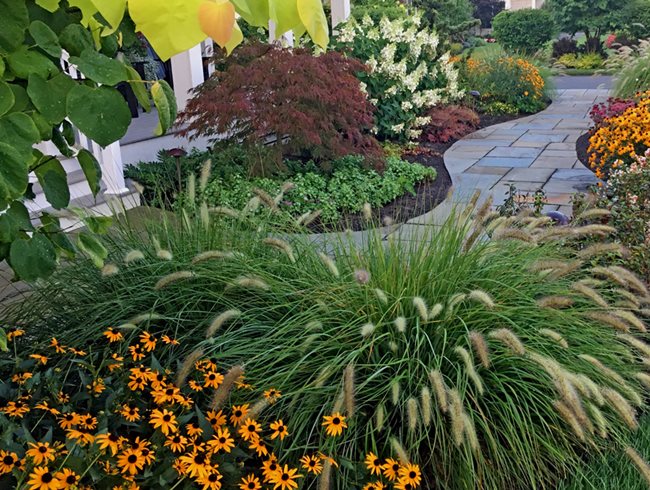
This inviting entryway garden features low-maintenance plantings of fountain grass, black-eyed Susan, abelia, Japanese maple, and ‘Tardiva’ panicle hydrangea. The lush full plantings help to suppress weeds, reducing the need for maintenance. Plants are left at the end of the growing season rather than pruned back in order to provide shelter and food for songbirds and other wildlife through fall and winter.
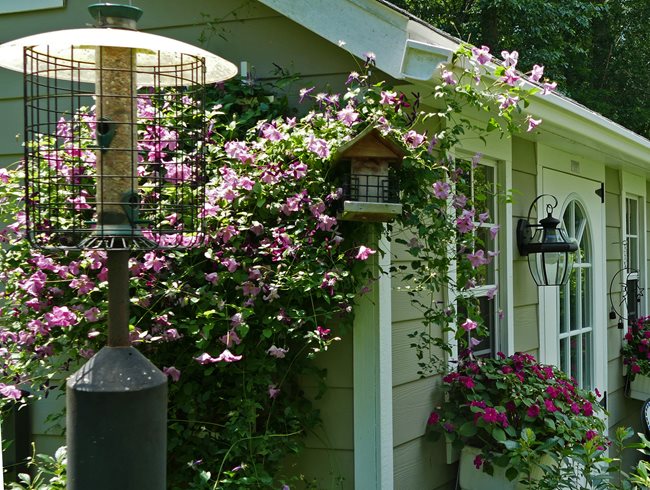
Feeders provide supplemental food, including shell-free seed mix, to support birds and other wildlife year-round.
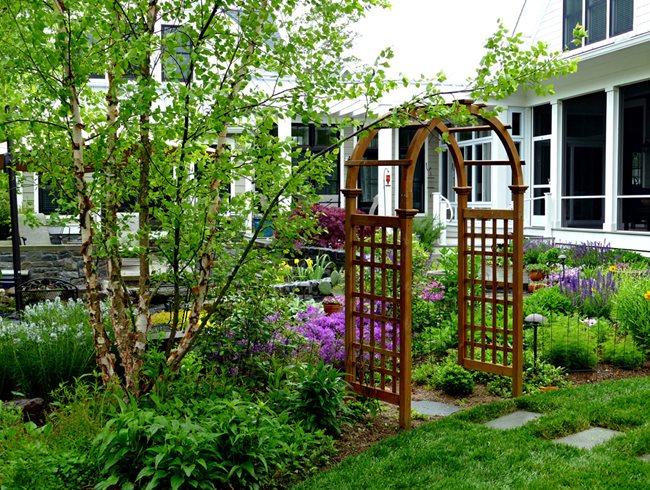
A series of garden rooms include perennial borders, sitting areas, and a vegetable garden. Pathways and arbors improve flow, drawing visitors through the garden. Larger specimens of river birch and other trees such as black gum, hemlock, and maples were brought in to make the 5-year-old garden look more established.
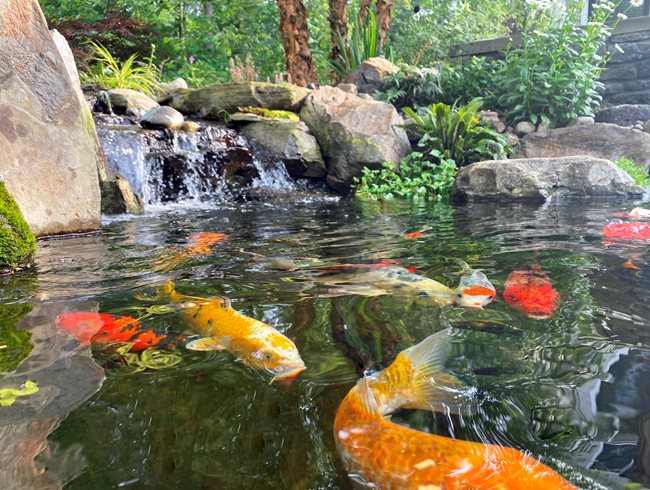
The natural pond and waterfall is a hub of activity, with regular visits from a variety of wildlife that come to drink and bathe. To protect the resident koi from raccoons, blue herons, and other predators, the pond has a sharp drop-off at the edges to keep wildlife from perching there. The pond was made 38 inches deep to give the fish places to hide. Cement was used to line the pond instead of a plastic liner that could be punctured by sharp animal claws.
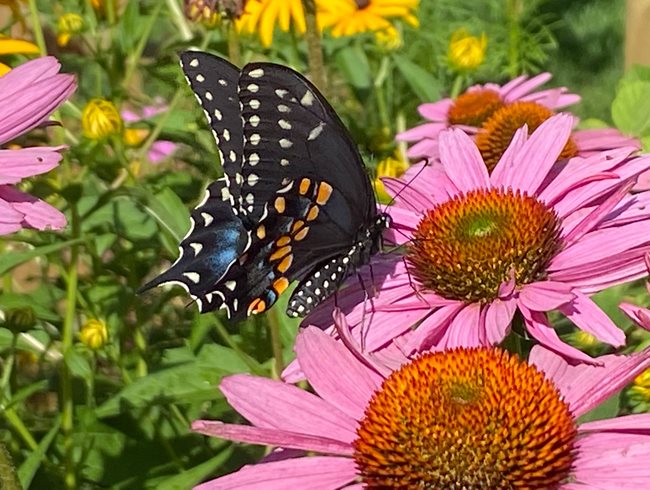
Patty and Morty’s garden attracts a wide diversity of beneficial insects, songbirds, amphibians, and mammals, including butterflies, hummingbird moths, frogs, turtles, snakes, foxes, possums, rabbits, flying squirrels, raccoons, skunks, otter, and deer. “We get some deer damage and apply repellent to select plants, but our goal is to co-exist with nature as much as possible,” says Morty. “The yard is magical at night with the meditative sounds of trickling water, croaking frogs, and chirping crickets.”
Featured in: Garden Design's Top 10 Garden Trends for 2022 ("Gardening for Wildlife")
TIPS FOR CREATING A WILDLIFE HABITAT
Wildlife habitat has been greatly reduced in recent years due to development and large scale farming. Homeowners can help by creating a haven in their own yards. Wildlife needs the basics of food, water, and shelter to survive and thrive. Here are some tips:
Plan:
Find out what kinds of insects, amphibians, birds, and mammals are in your area. For each species you would most like to attract to your yard, make a list of their preferences for food, water sources, and shelter.
Food:
Choose plants that provide food for different types of wildlife, from pollinating insects to songbirds. Plant-based food sources can include nectar, pollen, seeds, nuts, berries, fruit, and foliage. Supplemental food can include sugar water for hummingbirds and commercial seed and nut mixes for birds and squirrels. Provide regular supplemental food in winter when other food sources are scarce.
Feeding animals such as raccoons is not recommended, as they will come to associate food with humans and may become tame or aggressive.
Water:
Provide clean water for drinking and bathing. Water features include fountains, birdbaths, waterfalls, and ponds. Animals have preferences when it comes to the type of water source and are drawn to the sound of moving water. Place water sources in different spots around the yard. Refresh standing water in birdbaths and saucers frequently to deter mosquito larvae and prevent the growth of harmful bacteria.
Shelter:
Trees and shrubs offer cover for nesting, night shelter and refuge from weather elements and predators. Provide different types of cover that appeal to different species, and include evergreens that offer dense cover and shelter year-round.
Support reproduction:
Birds and other species have seen a decline in population. Provide places for them to nest and raise their young. Though trees and shrubs provide nesting habitat, nesting boxes are another way to insure birds have a secure place to raise their babies. Nesting boxes have particular specifications for different bird species.
Design elements:
- Use natural hardscape materials to add structure to the landscape, harmonize with informal plantings, and blur the distinction between manmade elements and nature.
- Incorporate rustic materials such as stone and wood for patios and decks. Use stone pavers or gravel for pathways.
- Large boulders and rocks serve as background features and focal points that simulate landscapes found in nature.
- Create comfortable seating areas around the yard where you can quietly sit and observe wildlife.
- Place feeders and birdbaths near windows to enjoy wildlife from indoors.
GARDENING FOR WILDLIFE
Start with good soil.
For the garden beds, Morty and Patty applied a 12-inch layer of a high-quality soil blend consisting of topsoil, sand, and 30 percent compost. “Good soil is the foundation for healthy plants,” Morty says.
Evaluate light and location.
Observe how the light falls in different parts of the yard throughout the day to determine where to site plants. Morty and Patty experimented with different varieties to see what would work best. “Don’t be afraid to remove a plant and try something else if it’s not working. When you start with good soil, it’s easy to dig plants out and move them around. We are constantly surprised to see what works and what doesn’t,” says Patty.
Go native.
Use plant species that are endemic to your area to best support local wildlife. Native plants are adapted to your climate, are low-maintenance and provide food for wildlife year-round.
Plant for multi-season interest.
Choose a variety of plants that will provide food in different seasons to keep wildlife fed throughout the year.
Go organic.
Avoid using chemical fertilizers and pesticides that can harm beneficial insects, birds and other wildlife.
Choose plants for wildlife.
Patty and Morty chose plants to attract and support particular species.
- Milkweed provides food for monarch butterfly larvae, while parsley is a host plant for black swallowtail butterflies to lay their eggs.
- Blackberry and raspberry bushes feed turtles, birds, and deer.
- A fern field offers shelter for frogs and turtles.
- Honeysuckle vine produces nectar for butterflies and hummingbirds.
- Squirrels feast on pine cones from conifers and acorns from oak trees.
- Bayberry shrubs provide seeds and shelter for a variety of birds.
- A diverse selection of trees, shrubs, and perennials produce pollen and nectar for pollinating insects such as bees and butterflies. These include Queen Anne’s lace, bee balm, lavender, goldenrod, monkshood, catmint, Joe pye weed, yarrow, cherry trees, and butterfly bush.
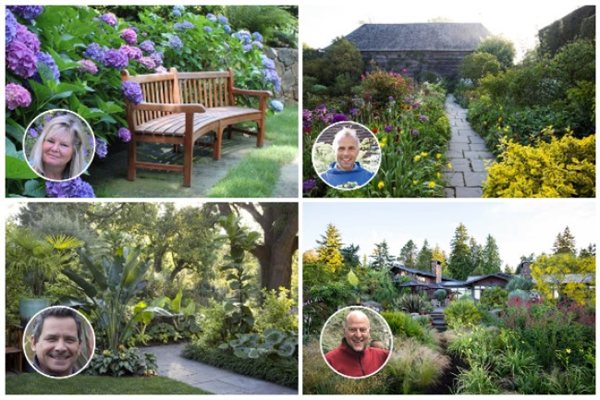
RELATED:
10 Ways to Start Building a Garden for Wildlife
Backyard Landscaping Ideas
Suburban Sanctuary
Natural Pools
